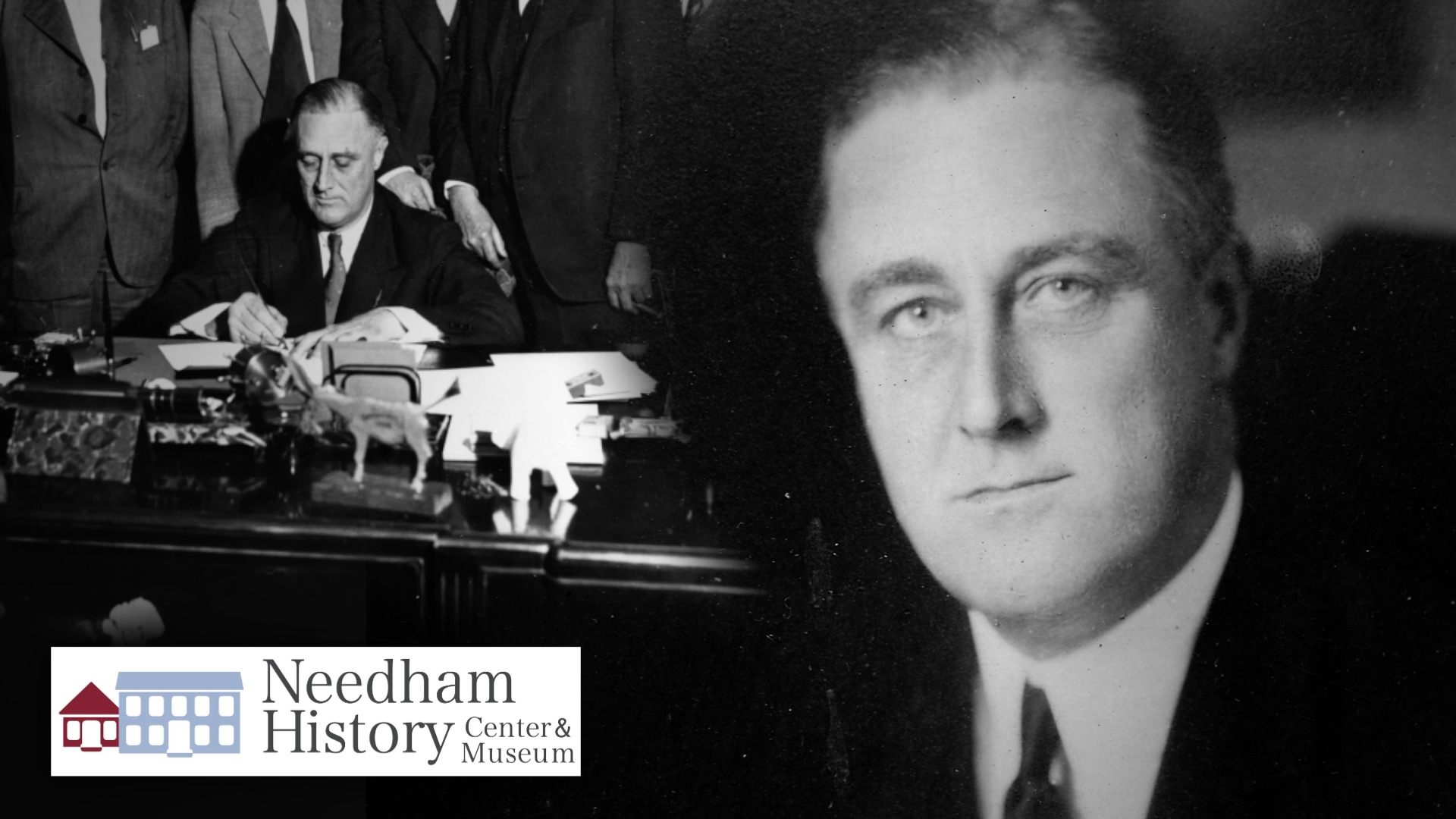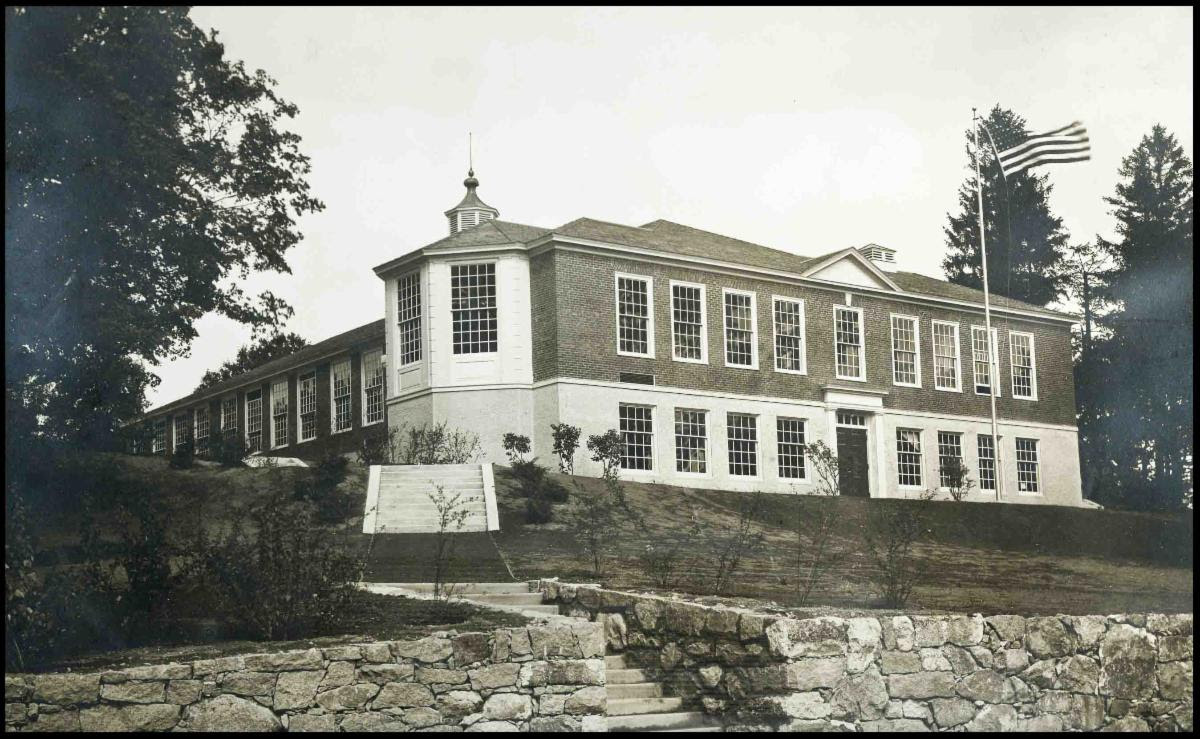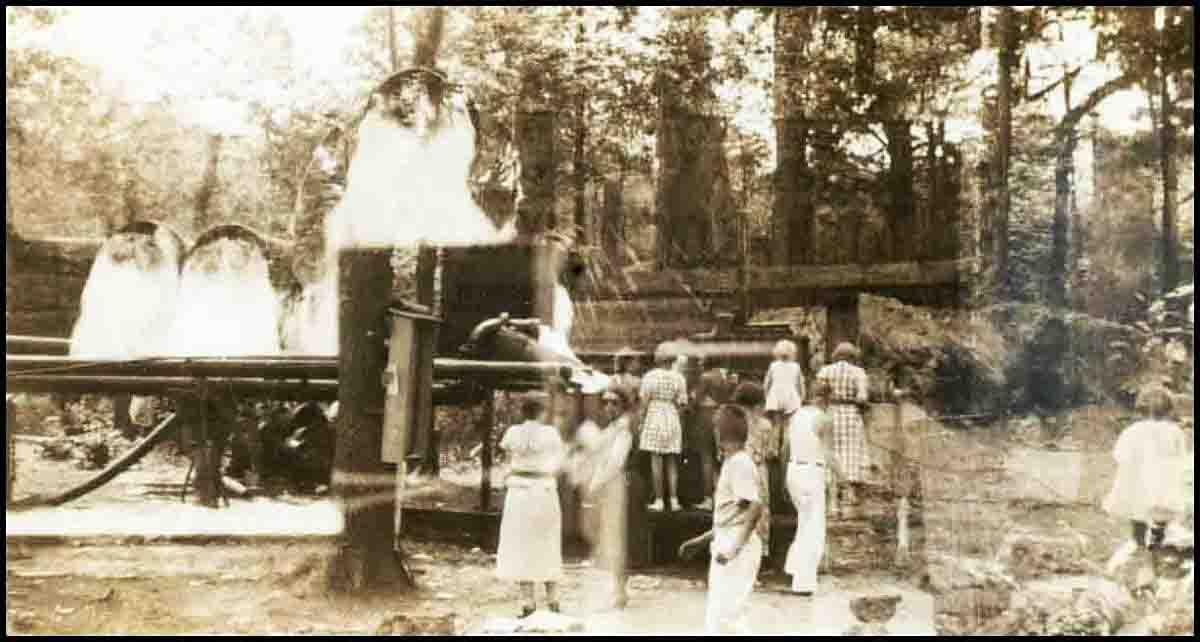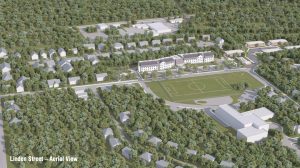
Needham History: The New Deal in Needham
“Poems are made by fools like me,
But God, I think, made Franklin D.”
 The Dwight School building on Central Avenue was built with WPA funding. It replaced the former Dwight Schoolhouse, a two-room wooden structure built in the 1870s.
The Dwight School building on Central Avenue was built with WPA funding. It replaced the former Dwight Schoolhouse, a two-room wooden structure built in the 1870s.
Work and Progress – the New Deal in Needham
By Polly Attridge, Archivist, Needham History Center
It was the 1930s, and our little town of Needham was in big trouble. But with a lot of help from Uncle Sam, we managed to survive.
In the 1920’s most of the United States was doing well after recovering from the First World War. By 1924, US citizens owned about 11 million homes. Electricity made life easier. Radios were common, as were automobiles. People might not be what they called rich, but most had a roof over their heads and knew where their next meal would come from. The majority of Americans were financially stable. The “Roaring 20’s” seemed pretty good.
Perhaps they were a bit too confident. The stock market was booming – quadrupling in value from 1920 to 1929. Many working-class citizens decided they, too, wanted to make stock investments, and did so “on margin”, which meant they paid as little as ten percent of the value, and then borrowed the rest from a bank or broker. The same overconfidence caused manufacturing and agriculture to overproduce. Soon there was a surplus of steel, household goods, produce, and iron, which depressed prices. A severe drought devastated the nation’s agriculture. The Federal Reserve raised the interest rate from 5 percent to 6 percent. People began to panic, selling off their stocks, and causing the stock market to crash on October 29, 1929 and plunging the nation into the Great Depression. Herbert Hoover was President, but he thought it was just “part of a passing recession.” But as the situation became worse, he still refused to involve the federal government, fearful that it would lead to Socialism.
At this point not only Needham, but the whole country was in trouble. Fifteen million people were out of work. Banks and businesses had closed. In many parts of the country bread lines were long, with people looking for something to eat. Here in Needham the newspaper was filled with mortgage foreclosures, and ads such as: “Wanted – odd jobs at painting by a man of 32, with family of 8, out of work for some time. 40 cents an hour“ and “Wanted – work as a mother’s helper or the care of children at 40 cents an hour by a young woman who has been out of work four years; has a mother dependent upon her.” Many had lost not only their jobs, but their savings and homes. People who thought they would never have to ask for anything were forced to stand in line asking for help.
Needham’s approach to beat the depression was twofold. The Red Cross, the Community Council, and the Taxpayers Association were examples of organizations that tried to find jobs for the needy, such as wood chopping in the winter and planting thrift gardens in the summer. Groups such as the Needham Chorus and the Needham Players put on benefit performances.
Town officials joined together and decided to provide jobs for 100 men, to work three days a week for $10.00. Then they adopted a new plan – all town employees would contribute a ten percent cut in their earnings. (And yes, the employees agreed to it.) The money was appropriated to the Welfare Department.
In January of 1933, when Franklin Delano Roosevelt began his first of four terms as president, he immediately began work on what he called the “New Deal.” It was a set of domestic policies that greatly expanded Government’s role in conquering the depression. What historians call the First New Deal (1933-1934) established several agencies to implement what were considered the necessary beginning steps, called the “3R’s.” First was Relief for the unemployed. Next was Recovery of the economy, through federal spending and job creation, and the third was Reform of capitalism, by means of regulatory legislation, and the creation of new social welfare programs.
Many of these agencies focused on public works for areas with large populations, such as LaGuardia Airport in New York City, and the River Walk in San Antonio, Texas. But several served the smaller towns, like Needham (population 11,828 in 1933). For example, the Civil Works Administration (1933-1934) provided a short term solution to get people back to work. This involved mostly unskilled male laborers who worked building bridges, repairing roads, and installing pipelines. Women were given jobs such as caring for the elderly, and working in school lunch programs and nursery schools.
The main goal of the Federal Emergency Relief Act (1933-1935) was to reduce household unemployment by creating unskilled jobs in local and federal government projects. FERA provided work for over 20 million people.
The Second New Deal passed further legislative reforms and created the groundwork for today’s modern social welfare system, including the creation of Social Security. Because FERA mandated that it would end two years after inception, on May 6, 1935, President Roosevelt signed into law a new program called the Works Progress Administration. The WPA was designed to expand and improve the actions of FERA; the Federal government paid for the labor, and the town furnished the equipment, materials, and supervision.
The WPA did not become effective in Needham until November of 1935. Although we know the agency paid (in round figures) $13,000 to the town that month, the records don’t show how that amount was split between FERA and WPA projects.
In 1936 the Federal Government supplied relief labor for the Town in the amount of $127,000, with the town adding $27,000 in administrative funds. The projects were new town construction works, installation of storm drains and sidewalks, and the installation of water mains from the new well on Charles River Street. The Forestry Division protected town shade trees by trimming the trees and suppressing gypsy moth caterpillars. The Recreation Department used WPA-paid workers to supervise soccer, skating, and hockey at Rosemary Lake, and lifeguards during the hot summer swimming days.
1937 brought the Town $65,000 for labor, while Needham paid $28,000 for administration funds. In addition to the usual water main and drain construction, repairs were made to Birds Hill Brook, and help was given in the Engineering and Recreation departments. Women were paid to sew clothes for destitute families. A commodity distribution store was opened near the railroad tracks in the Town Center that provided food and clothing for the workers. Federal funds were paid to an average of 95 workers per week.
In 1938 the WPA paid the town $72,000 for labor, and town funds were $38,000. Although most of the work done by the WPA was an extension of previous work, the infamous Hurricane of 1938 caused extensive damage throughout the town. By actual count, 822 Town shade trees and 180 privately-owned trees were blown down across streets, and 98 town trees were so badly damaged they had to be removed. The WPA was used extensively for that cleanup work.
For 1939 the WPA paid $67,000 and the Town contributed $20,000. Assisting with classifying records in the town’s vault, and completion of veteran’s grave records were added to the list of WPA work, but there were also three major projects: two of them being storm water drainage installation (a lesson taught by the hurricane) and the construction of approximately seven miles of tar and gravel sidewalks; and the third was the construction of the Dwight School on Central Avenue (now part of the Charles River Center).
During the summer of 1940 a large quota reduction was made, and only 49 workers were on the payroll by September. However, an average of 73 workers per month were paid $50,000 during the year, and the Town cost was $20,000. As an augury of things to come, an item in the annual Town Report said that: “It is doubtful if there will be any noticeable increase this year due to the defense program now in operation.” However, the usual work was done, in spite of extreme difficulties in laying a sewer line for Marked Tree Road and High Rock Street due to the necessity of excavating the hardest type of rock ever found in Needham.
In 1941 and 1942, the subsidies continued to decline. In 1942 eighteen workers from Needham were transported to a federal project in Hingham. By the end of the year all manual work was suspended and only six workers were assigned. The Town Report shows no income from the WPA that year, and, funds paid by the town came to only $5,000 – nearly all of which was transportation for the Hingham project.
When the WPA program was ended on June 30, 1943 the Federal Government had paid Needham roughly $404,000 for labor, with the Town paying about $152,000 for the materials used. The town had a new and modernized infrastructure. Many of the WPA facilities built across the country are still used today. The WPA may have paid low wages and was not able to employ everyone, but the good it did was remarkable, enabling millions of Americans to remain fed and housed. But one of the most important results was the bolstering of the self-esteem of millions of workers, who instead of being on welfare, were working at paying jobs.
Perhaps the feeling was best described by the following poem, written in block letters – sent to President Roosevelt by one of them:
“I THINK THAT I SHALL NEVER SEE
A PRESIDENT LIKE UNTO THEE.
POEMS ARE MADE BY FOOLS LIKE ME,
BUT GOD, I THINK, MADE FRANKLIN D.”
Checking out the new Charles River Street pumping station in 1936, which still provides the majority of the town’s well water.
 |
Polly Attridge has been the Needham History Center’s Archivist for more years than Gloria has fingers and toes, and Gloria could not function without her. |

